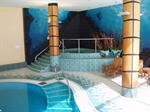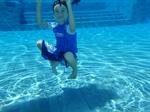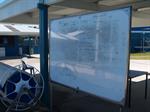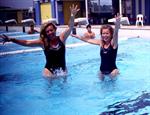
Become an Expert in Aquafitness
This is a great course for:
- Individuals wanting to improve fitness after injury or surgery
- Fitness Instructors wanting to expand knowledge and skills
- Anyone working in Rehabilitation, allied health or health support services
- Sports coaches, life coaches, physical education teachers, etc
Course Structure
This subject has 7 lessons as follows:
- Introduction
- Scope and Nature of Aqua Exercise
- Characteristics of Water; Buoyancy, Cooling, Decreased compression forces, Hydrostatic Pressure, Increased Resistance, etc
- Respiratory Fitness
- Aquatherapy; for flexibility, strength, muscle re-education, balance, muscle spasms, etc
- Physiology of an Aqua Exercise Session; stages 1, 2 and 3
- What Affects Fitness
- Managing Aqua Facilities

- Types of Exercises
- Stretching
- Calf muscles
- Pectoral girdle
- Hip flexor
- Triceps
- Hamstrings
- Biceps
 Quadriceps
Quadriceps - Lower and upper back
- Types of Exercises
- Aerobic Exercise
- Anaerobic Exercise
- Exercises for Shallow Water
- Exercises for Deep Water
- Deep Water Running
- Intensity Variables; speed, power, range of movement, elevation
- Teaching Deep Water Running
- When You Get in the Water
- Hydrostatic and Hydrodynamic Principles
- General Principles of Aquafitness
- Specific Gravity, Pressure, Flow, Energy, Momentum
- Buoyancy in the Water
- Warm Up
- Recovery
- Winding Up an Exercise Session
- Cool Down Stage
- Muscle Conditioning
- Weight in Water
- Body Alignment in Water
- Knee Safety
- Training Heart Rate
- Safety & Health
- Exercises for Special Groups
- Health Disorders
- Aged People
- Overweight People
- Arthritis, Asthma and Diabetes Sufferers
- Pregnant Women
- Fibromyalgia Sufferers
- Safety and Health
- Pre Exercise Screening Checklist
 Legal Liability
Legal Liability - Insurance
- Contributory Negligence
- Occupational Health and Safety
- Program Design
- Requirements to Deliver Appropriate Aqua Based Programs
- Process for Program Design
- Improving Cardio Respiratory Fitness
- Building Strength
- Improving Flexibility
- Duration of Sessions
- Examples of Types of Programs
- Stages of a Program; Introduction, Warm Up, Main Body, Intensity Levels, Recovery
- Concluding a Session and Cool Down
- Writing a Program Plan
- Leading a Program
- Leading a Class
- When you Teach from the Pool
- Teaching out of the Pool
- Teaching both In and Out of the Pool
- Introducing New People to an Aqua Class
- Leadership Concepts
- Leader Communication
- Common Communication Barriers
 Appropriate Numbers in a Class
Appropriate Numbers in a Class - Preparing for a Class
- Tips for Running a Class
Each lesson culminates in an assignment which is submitted to the school, marked by the school's tutors and returned to you with any relevant suggestions, comments, and if necessary, extra reading.
Background
This course was developed as a fitness leaders elective module and for many years accredited through national accreditation bodies in Australia and the UK. With changes to accreditation systems and a reduction in content required for fitness leader accreditation, the formal accreditations lapsed, but the course remains has continued to be maintained (and periodically updated), in line with the original quality standards.
ALWAYS WARM UP FIRST
A person is more susceptible to the following injuries if they exercise without warming up first:
- Torn muscle tissue
- Damage to joints
- Cardiac problem
Warming up does the following:
- It gets the muscles moving and in doing so begins to lubricate the joints
- It gently stretches the muscles conditioning them for more vigorous movements to follow.
- It increases the heart rate and respiration slowly which is safer than a rapid increase.
- Increases the capacity to take in and utilise oxygen
- Undertaking a warm up will also help the transmission of impulses through the nerves.
- The hormone system is alerted.
- Energy sources become activated.
- Activity in the Central Nervous System is increased which leads to faster reaction times.
- It may psychologically prepare class members for more vigorous exercise.
This warm up can be achieved by any gentle movement such as walking, either in or out of water, gradually increasing the intensity or effort, and ensuring that a wide variety of muscles in all parts of the body are moving.
There are five aspects to the warm up:
1. The overall body temperature is increased by overall general movement such as running or jumping. The heart rate should be increased gradually and sustained at a raised level for perhaps 5 minutes. The intensity and duration of this part of the exercise will depend upon the individual’s level of fitness and the environmental conditions It can take longer to warm up if exercising in colder water
2. Major muscle groups should be utilised first then smaller groups.
3. Blood flow to specific areas may need to be increased during warm up. The muscles are then targeted, and the importance of this will depend on the condition of the individual and the purpose of the exercise session. If exercise is being undertaken for therapy of an injury in the arms, then prescribed arm exercises might be important during this warm up stage.
4. The muscles which are to be involved in the exercise session should be stretched gradually. The range of exercises prescribed in this warm up stage should ideally encompass comfortable stretches – each for at least 20 seconds duration.
5. The joints which are to be involved in the exercise session should be moved gently at first. Extend intensity and range of movement gradually.
WHO SHOULD LEARN ABOUT AQUAFITNESS?
-
Fitness Leaders
-
Remedial Therapists
-
Sports Coaches, Personal Trainers
-
Athletes
-
Anyone with inhibited capacity to move -injured people, older people, people recovering from injury, people with muscle or joint problems ....
Aquafitness is low impact exercise, and as such, has massive advantages over and beyond anything done out of the water, from football to running and cycling to tennis.